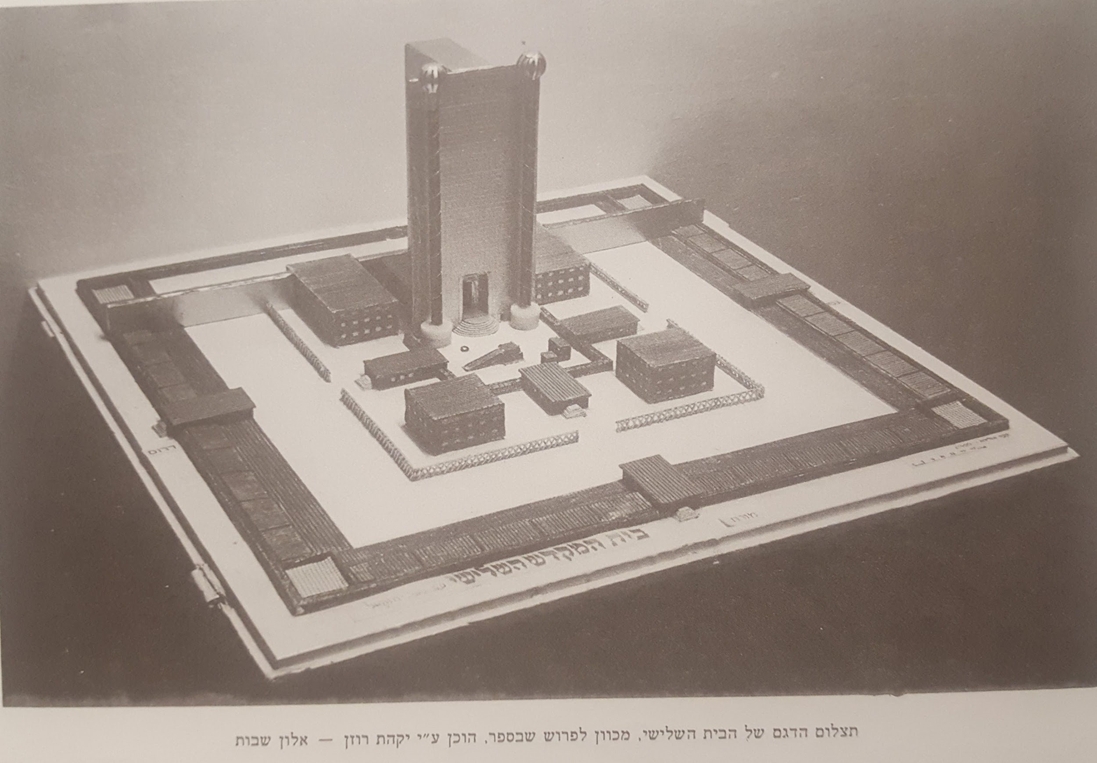Tetzaveh
Ezekiel, the prophet of the Babylonian exile, shares visions of rebuke and of redemption. The last eight chapters of his book describe an extended vision during which he is physically transported from Babylon to Jerusalem to behold a rebuilt Temple, God’s glory returned to it, and His presence restored among His people. Its first four and a half chapters describe the restored Temple’s dimensions, shown to him by a man-like guide on Yom Kippur, 572 BCE (Ezek. 40:1).
The Haftarah opens with that inspirational section’s conclusion, a comforting rebuke to the Jews exiled in Babylon. By learning about God’s rebuilt Temple, they will become ashamed of their sins that led to the Temple’s destruction, and learn to aspire to a renewed, exalted one. The Haftarah’s second section continues by detailing the dimensions of the new Temple’s sacrificial altar (43:13-17), and concludes with the sacrificial procedures for the seven days of its inauguration and the restoration of His relationship with His people thereafter. The Parashah similarly describes God’s presence dwelling amidst His people and in His Temple after seven days of inaugural sacrificial and purification procedures for priests and the Mishkan (Tabernacle).
Haftarah Breakdown
Verses 43:10-12: God tells Ezekiel to recount the future Temple’s measurements as inspirational chastisement.
Ezekiel 43:11
If they are ashamed of all they have done, make known to them the House’s form, and its design, exits, and entrances, all its forms, all its ordinances, all its shapes, and all its laws. Write [these] before their eyes [so] that they may keep its whole form and all its ordinances, and do them.
וְאִֽם־נִכְלְמ֞וּ מִכֹּ֣ל אֲשֶׁר־עָשׂ֗וּ צוּרַ֣ת הַבַּ֡יִת וּתְכוּנָת֡וֹ וּמוֹצָאָ֡יו וּמוֹבָאָ֣יו וְֽכָל־צֽוּרֹתָ֡ו וְאֵ֣ת כָּל־חֻקֹּתָיו֩ וְכָל־צורתי [צ֨וּרֹתָ֤יו] וְכָל־תורתו [תּוֹרֹתָיו֙] הוֹדַ֣ע אוֹתָ֔ם וּכְתֹ֖ב לְעֵֽינֵיהֶ֑ם וְיִשְׁמְר֞וּ אֶת־כָּל־צוּרָת֛וֹ וְאֶת־כָּל־חֻקֹּתָ֖יו וְעָשׂ֥וּ אוֹתָֽם׃
Verses 43:13-17: Ezekiel enumerates the measurements of the new Temple’s altar.
Ezekiel 43:13
These are the Altar’s measurements by cubits: a cubit is a cubit and a handbreadth. The bottom shall be a cubit, and the breadth a cubit. Its border by its edge all around shall be a span. This shall be the Altar’s top.
וְאֵ֨לֶּה מִדּ֤וֹת הַמִּזְבֵּ֙חַ֙ בָּֽאַמּ֔וֹת אַמָּ֥ה אַמָּ֖ה וָטֹ֑פַח וְחֵ֨יק הָאַמָּ֜ה וְאַמָּה־רֹ֗חַב וּגְבוּלָ֨הּ אֶל־שְׂפָתָ֤הּ סָבִיב֙ זֶ֣רֶת הָאֶחָ֔ד וְזֶ֖ה גַּ֥ב הַמִּזְבֵּֽחַ׃
Verses 43:18-21: The man conveys God’s commands to Ezekiel regarding the Altar’s inauguration, describing the first day of the inauguration ceremony. Priests of the Tzadok family shall serve in the Temple.
Ezekiel 43:18
And [the man] said to me, “Son of man, thus says the Lord God: ‘These are the Altar’s [inaugural] procedures when it is made: to offer burnt offerings upon it, and to sprinkle the blood upon it.’”
וַיֹּ֣אמֶר אֵלַ֗י בֶּן־אָדָם֙ כֹּ֤ה אָמַר֙ אֲדֹקי ה' אֵ֚לֶּה חֻקּ֣וֹת הַמִּזְבֵּ֔חַ בְּי֖וֹם הֵעָֽשׂוֹת֑וֹ לְהַעֲל֤וֹת עָלָיו֙ עוֹלָ֔ה וְלִזְרֹ֥ק עָלָ֖יו דָּֽם׃
Verses 43:22-26: God describes the sacrificial and purifications procedures for the rest of the inaugural week.
Ezekiel 43:26
Seven days they shall [thus] cover [and thereby atone for] the Altar and purify it, and they shall consecrate it.
שִׁבְעַ֣ת יָמִ֗ים יְכַפְּרוּ֙ אֶת־הַמִּזְבֵּ֔חַ וְטִהֲר֖וּ אֹת֑וֹ וּמִלְא֖וּ יָדָֽו׃
Verse 43:27: After the rededication concludes, God will accept the Jewish people and their priests’ Altar offerings.
Ezekiel 43:27
“When these days conclude [then on the eighth day and onwards, the priests shall make upon the altar your burnt offerings and your peace offerings. I will accept you,” says the Lord God.
וִֽיכַלּ֖וּ אֶת־הַיָּמִ֑ים (ס) וְהָיָה֩ בַיּ֨וֹם הַשְּׁמִינִ֜י וָהָ֗לְאָה יַעֲשׂ֨וּ הַכֹּהֲנִ֤ים עַל־הַמִּזְבֵּ֙חַ֙ אֶת־עוֹלֽוֹתֵיכֶם֙ וְאֶת־שַׁלְמֵיכֶ֔ם וְרָצִ֣אתִי אֶתְכֶ֔ם נְאֻ֖ם אֲדקי ה'׃ (ס)
Connections
The Midrash derives the importance of studying the structures of the Temple from the Haftarah.
Pesikta Rabbati 16:1
Shmuel said, "’If they are ashamed of all they have done [make known to them the House’s form]..." (Ezekiel 43:11)’ Is there a House [Temple] layout nowadays? [No!] Instead, the Holy One, blessed be He, said, "Since you engage in [studying] it, it is as if you build it."
שמואל אמר: "ואם נכלמו מכל אשר עשו וגו" (יחזקאל מ״ג:י״א) וכי יש צורת הבית עד עכשיו? אלא אמר הקב"ה הואיל ואתם מתעסקים בו כאילו אתם בונין אתו.
Ezekiel’s Temple, as shown in the Da’at Mikra volume of Ezekiel.
(With permission from Mossad HaRav Kook-Jerusalem, publishers of the Da’at Mikra series)
With emendations, all translations are from Sefaria.org. To dedicate, comment, or subscribe, email haftarahhelper@gmail.com.

